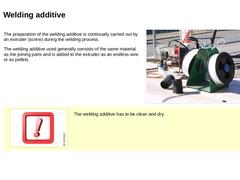
|

| (Image: Welding of the liner ends by means of Extruder welding - Trovidur welding additive)
The preparation of the welding additive is continually carried out by an extruder (screw) during the welding process. The welding additive used generally consists of the same material as the joining parts and is added to the extruder as an endless wire or as pellets. | | (Image: Attention!)
The welding additive has to be clean and dry. |
|
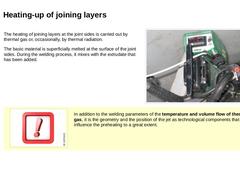
|

| (Image: Welding of stud hose using the HD-PE-fleece and extruder welding device – a brief look at the temperature display)
The heating of joining layers at the joint sides is carried out by thermal gas or, occasionally, by thermal radiation. The basic material is superficially melted at the surface of the joint sides. During the welding process, it mixes with the extrudate that has been added. | | (Image: Attention!)
In addition to the welding parameters … |
|
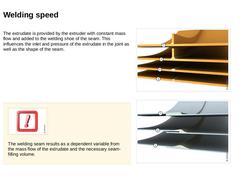
|

The extrudate is provided by the extruder with constant mass flow and added to the welding shoe of the seam. This influences the inlet and pressure of the extrudate in the joint as well as the shape of the seam. (Image: Possible shapes of welding seams during extrusion welding) (Image: Attention!) The welding seam results as a dependent variable from the mass flow of the extrudate and the necessary seam-filling volume. (Image: Possible shapes of welding … |
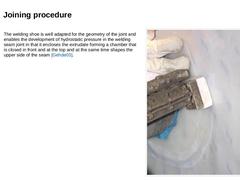
|

| (Image: Welding the top hat sleeve - detail)
The welding shoe is well adapted for the geometry of the joint and enables the development of hydrostatic pressure in the welding seam joint in that it encloses the extrudate forming a chamber that is closed in front and at the top and at the same time shapes the upper side of the seam [Gehde03]. |
|
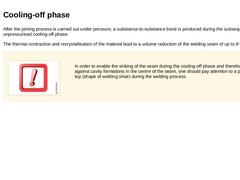
|

After the joining process is carried out under pressure, a substance-to-substance bond is produced during the subsequent unpressurised cooling-off phase. The thermal contraction and recrystallisation of the material lead to a volume reduction of the welding seam of up to 8 % [Gehde03]. In order to enable the sinking of the seam during the cooling-off phase and therefore to work against cavity formations in the centre of the seam, … |
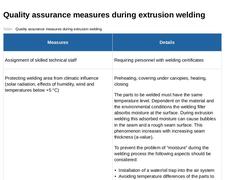
|

(Table: Quality assurance measures during extrusion welding) |
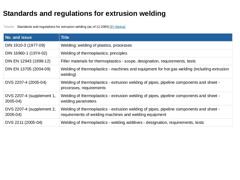
|

|
(Table: Standards and regulations for extrusion welding (as of 12.2005) [FI-Steina]) |
|

|

|
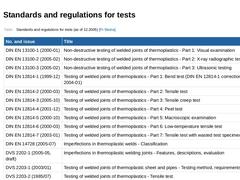
|

|
(Table: Standards and regulations for tests (as of 12.2005) [FI-Steina]) |
|
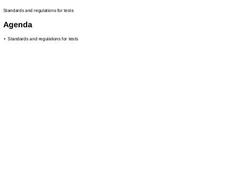
|

|

|

This module focuses on the theoretical background and the practical conditions to be observed on the subject of welding of polyethylene pipes for gas, water and wastewater pipelines. A further focus is on the requirements to be considered in quality assurance and in particular the consequences of non-compliance. After completing this module, you will have a sound knowledge of: - process steps of plastic welding;
- consequences of non-professional plastic welding work;
- necessary quality assurance measures.
|

|
There exist numerous methods for cleaning drain and sewer systems. They are applied in dependence on the cleaning objective and the structure-specific, local, structural and hydraulic limiting conditions. (Image: Overview of the drain and sewer cleaning methods as per [Führb1980]) |

|
Selection of cleaning measures must be in accordance with the relevant standards (e.g. DIN EN 14654-1, AWWA G520-17, and ASCE 2019), and should also take into account the technical feasibility and economic viability, as well as the following boundary conditions: -
Type, quantity and composition of deposits and obstacles
-
Ease of access
-
Road type and traffic situation
-
Depth of cover
-
Cross-section and dimensions
-
Change in cross-section or displacement
|

|
According to [EN14654-1:2005], high-pressure cleaning is "the use of high-pressure equipment to remove obstacles and deposits in drains and sewers". This universal method, which is applied in about 90% of all sewer cleaning measures in Germany, is also used as a preparatory action prior to an inspection or a rehabilitation [Geib2002]. (Image: Combined flushing/vacuum vehicle) (Image: Combined flushing/vacuum sewer cleaning vehicle) |

|
The process of high-pressure cleaning firstly removes any existing deposits using flushing water. These deposits are then transported to a delivery point, e.g. a manhole, where they are collected, drained of water if necessary, and disposed of. By means of a high-pressure pump, the flushing water is pumped from a reservoir through a high-pressure flushing hose with a cleaning nozzle installed at its end. (Image: Combined flushing/vacuum sewer cleaning … |

|
(Video: Radial nozzle in operation - retrieval) Animation: High pressure flushing process [Image: visaplan GmbH]. This interactive object is only visible in the online version of the module. (Video: Radial nozzle in operation [FI-Wiede]) Video: Radial nozzle in operation [FI-Wiede]. This interactive object is only visible in the online version of the module. Video: Radial nozzle in operation - retrieval [FI-Wiede]. This interactive element is only visible … |

|
At this point the debris is generally collected using a vacuum pump and a suction tube, this method is referred to as combined high-pressure cleaning (subsequently simply referred to as high-pressure cleaning). According to [EN14654-1:2005], the term describes "the simultaneous use of high pressure devices and a vacuum to remove obstacles or deposits in drains or sewers". (Image: Vacuum-water-ring pump from the Super 2000 vehicle of the company Wiedemann & … |

|
(Image: Sewer cleaning work flow - Cleaning vehicle) 1. Cleaning vehicle (Image: Sewer cleaning work flow - traffic control) 2. Traffic control (Image: Sewer cleaning work flow - Opening of the manhole) 3. Opening of the manhole (Image: Sewer cleaning work flow - Installation of the cleaning nozzle) 4. Installation of the cleaning nozzle (Image: Sewer cleaning work flow-Nozzle test) 5. Nozzle test (Image: Hose roller/guide in use) 6. Hose roller/guide in use |

|
The high-pressure cleaning process utilises different types of vehicles depending on the limiting conditions and site location [SteinD00]. (Image: Cleaning vehicles - High pressure flushing vehicle) High-pressure flushing vehicles are used for a hydro-dynamic cleaning of drains and sewers. They are equipped with two-axle, three-axle or four-axle chassis and have no suction capabilities. (Image: Cleaning vehicles - Suction vehicle) |

|
(Table: Cleaning vehicles – advantages and disadvantages) |

|
(Table: High-pressure cleaning vehicle applications) |

|
(Table: Comparison between high-pressure flushing vehicles and sewer and catch basin cleaning vehicle) |

|
The flushing water required for cleaning is taken from the water supply network via stand pipes. A direct connection to a hydrant is prohibited. Generally, a permission under the Water Act and a specially equipped high-pressure flushing vehicle, e.g. in the form of filter ejectors, are required for the extraction of water from open bodies of waters. (Image: HP flushing vehicle - water collection from an open water source) (Image: Water collection from … |

|
In recent years, the use of combined high-pressure flushing and vacuum vehicles with water treatment technology (picture) has become more common. (Image: High-pressure flushing and suction vehicle with water treatment technology) |

|
(Image: High-pressure flushing and suction vehicle – components) |